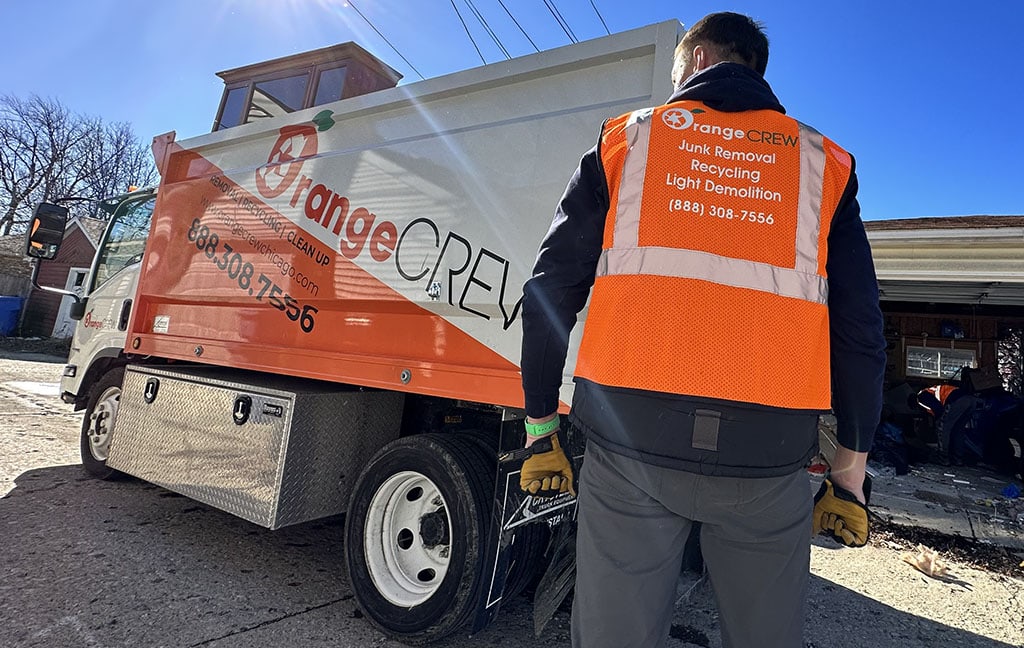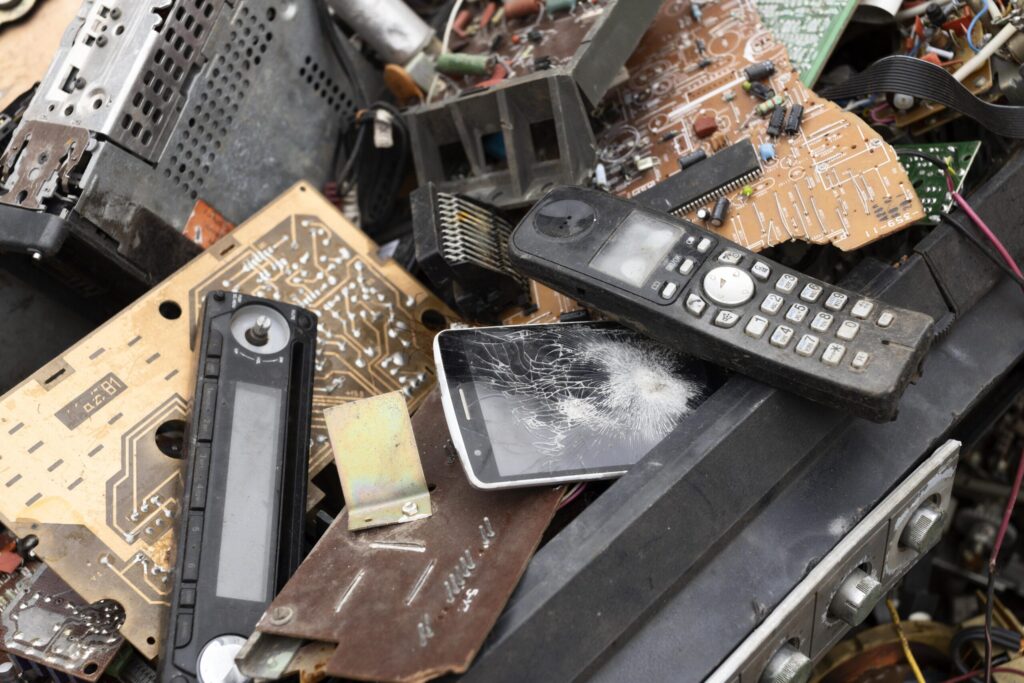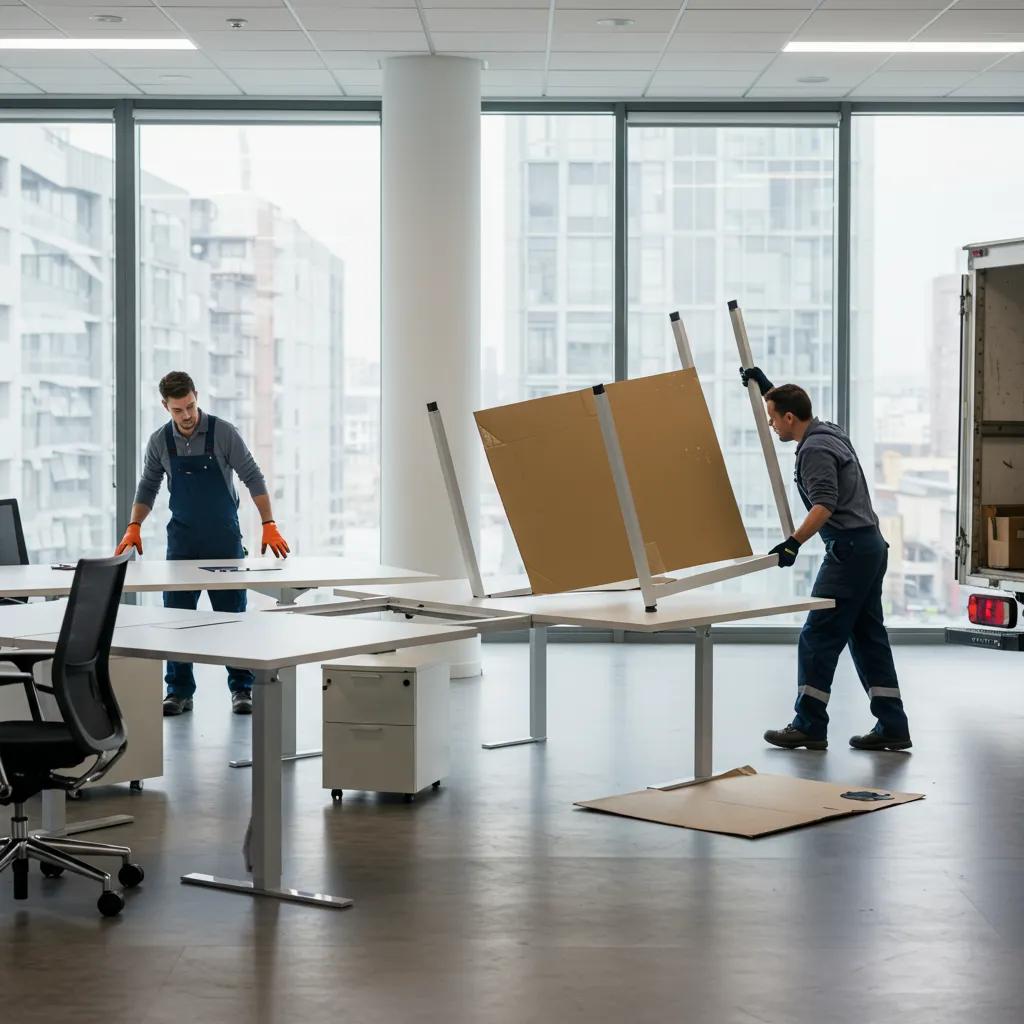
Why Office Furniture Removal Matters for Your Business: Key Benefits and Professional Solutions
Removing outdated or unwanted office furniture is the deliberate process of clearing desks, chairs, cubicles, filing cabinets, and electronics to reclaim workspace, reduce hazards, and support sustainability. This article explains why office furniture removal matters for businesses, how professional services improve safety and efficiency, and which disposal methods deliver environmental and financial value. Many organizations face costly downtime, safety incidents, and missed opportunities for space optimization when old furniture lingers; targeted removal addresses those problems while supporting corporate responsibility and regulatory compliance. You will learn the main benefits of removal, why hiring professionals often makes sense, eco-friendly disposal options, cost drivers and savings strategies, and the regulatory checklist to manage risk. Practical lists, comparison tables, and implementation tips are included so facility managers and business leaders can make informed decisions about office cleanouts, commercial junk removal, and office decommissioning. Throughout, semantic terms like office furniture removal services, commercial junk removal, e-waste recycling, and donate office furniture are used to clarify choices and actions.
What Are the Main Benefits of Office Furniture Removal for Businesses?
Office furniture removal improves productivity, safety, space utilization, aesthetic coherence, and sustainability by clearing impediments and enabling purposeful redesign. Removing outdated assets reduces visual clutter and physical bottlenecks, which directly improves workflow and team collaboration. The section below lists the primary benefits and then presents a compact EAV-style table mapping benefits to measurable outcomes so decision-makers can prioritize actions. Removing furniture also creates opportunities for asset liquidation, donation, or recycling that can offset costs and support corporate social responsibility.
Office furniture removal delivers several measurable benefits:
- Decluttered Office: Clearing unused furniture reduces distractions and streamlines circulation paths.
- Improved Safety: Removing broken or unstable items lowers trip and manual-handling injury risk.
- Space Optimization: Reclaimed square footage enables new meeting areas or collaboration zones.
- Sustainability Value: Recycling and donation divert waste from landfill and improve brand reputation.
These benefits translate into operational gains that justify planning and execution, and the following table maps those outcomes to concrete business impacts.
| Outcome | Measured Impact | Typical Business Result |
|---|---|---|
| Decluttered office | Fewer interruptions, clearer circulation | Improved employee focus and faster task completion |
| Improved safety | Reduced incident reports and claims | Lower liability and absenteeism rates |
| Space optimization | Reclaimed usable square footage | Opportunity for higher utilization or downsizing |
| Sustainability actions | Tons diverted / donations made | Positive PR and CSR reporting metrics |
This mapping helps prioritize removal efforts by linking each action to tangible workplace or reputational metrics and shows why removal is a strategic business decision that sets up the next topic: how removal boosts productivity in specific ways.
How Does Furniture Removal Enhance Workplace Productivity?
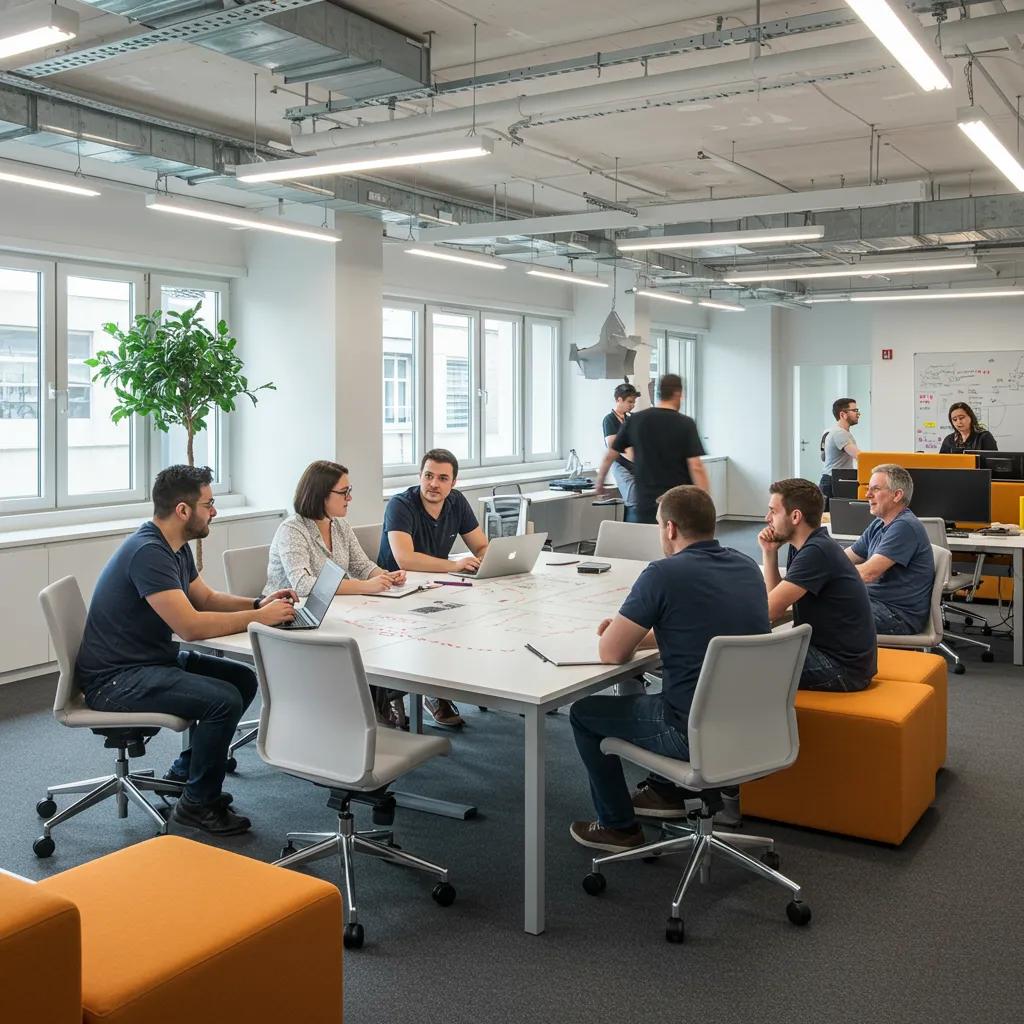
Furniture removal enhances productivity by eliminating physical and visual obstacles that interrupt workflows, enabling clearer circulation and better sightlines for collaboration. When teams reclaim meeting rooms or consolidate workstations, employees experience fewer logistical delays and can transition faster between tasks. Thoughtful removal also allows reconfiguration into collaborative pods or quiet zones, aligning space with work modes and improving task focus. These immediate layout improvements reduce time wasted navigating around obsolete furniture and create a foundation for further space optimization efforts.
In What Ways Does Removing Old Furniture Improve Employee Safety?
Removing old furniture mitigates safety hazards such as broken chair mechanisms, unstable shelving, and tripping obstacles that cause strains and falls. Professional removal protocols include safe disassembly, proper lifting techniques, and secure transport that reduce injury risk for staff during cleanouts. Clearing heavy or awkward items prevents repetitive-lift incidents and protects both employees and the organization from related costs and claims. Implementing removal as part of routine maintenance reduces long-term exposure to hazards and supports a safer workplace culture.
How Can Office Furniture Removal Maximize Space and Improve Office Aesthetics?
Removing obsolete furniture creates immediate visual and functional improvements by opening sightlines, increasing natural light flow, and defining clear circulation paths. Reclaimed space can be repurposed for collaboration areas, touchdown stations, or amenity zones that support modern work patterns and brand presentation. Upgrading or removing mismatched pieces creates cohesive aesthetics that reinforce company identity and employee pride. These spatial and visual changes often lead teams to reimagine workflows and enhance overall office utilization.
Why Is Professional Office Furniture Removal Important for Your Business?
Professional office furniture removal brings trained crews, specialized equipment, and coordinated logistics that reduce downtime and mitigate risk during cleanouts and decommissioning. Professionals plan removal steps—assessment, scheduling, safe removal, transport, and appropriate disposal—so businesses avoid ad-hoc delays, repeated trips, and regulatory missteps. The next list highlights core professional advantages and the short example paragraph after it shows how service features translate to operational value for companies planning moves, renovations, or downsizing.
- Speed and Scheduling: Rapid appointments and staged removal reduce operational disruption.
- Safety and Expertise: Trained teams handle disassembly and heavy lifts safely.
- Disposal Channels: Access to recycling, donation, and certified e-waste routes ensures responsible disposal.
- Transparent Pricing: Upfront quotes and clear scope reduce surprises during projects.
Working with a reliable provider minimizes operational downtime and ensures compliance with disposal rules. For example, partnering with a local commercial junk removal specialist that offers fast, reliable, and efficient service can let an office complete a staged renovation with minimal interruption to daily operations while ensuring items are recycled or donated where possible.
What Expertise and Efficiency Do Professional Services Provide?
Professional crews provide expertise in handling diverse items—desks, cubicles, conference tables, and electronics—using the right tools to disassemble and remove safely. Efficient teams coordinate logistics, access routes, elevators, and timing to limit interference with business hours and critical deadlines. Their knowledge of disposal channels ensures items we remove eligible for donation or recycling avoid landfill, preserving value and supporting sustainability goals. This efficiency reduces indirect costs tied to lost productivity and iterative removal attempts.
How Do Tailored Removal Solutions Meet Different Business Needs?
Tailored removal solutions scale across relocations, phased renovations, downsizing, or one-off decluttering projects by adjusting crew size, timing, and disposal methods to the business’s needs. For renovations, staged removals protect ongoing operations; for downsizing, bulk pickup and asset liquidation can recover value. Custom plans also allow scheduled off-hours work to avoid peak activity windows and reduce interruption. These flexible approaches help organizations align removal with project timelines and business continuity objectives.
(Company integration: Orange Crew Chicago provides fast, reliable, and eco-friendly commercial junk removal tailored to business schedules. Their model emphasizes minimal disruption, clear upfront quotes, and diversion to recycling or donation channels where appropriate, illustrating how professional services can implement the efficiencies and responsible disposal practices described above.)
How Does Sustainable Office Furniture Disposal Benefit Your Business and the Environment?
Sustainable disposal—recycling, donation, repurposing, or certified e-waste recycling—reduces landfill waste while producing business value through tax benefits, CSR reporting, and improved stakeholder perception. Choosing appropriate channels for desks, chairs, and electronics ensures functional items find new users and hazardous components are handled by certified recyclers. The table below compares disposal methods by environmental and business value to help facilities choose the best path. Emphasizing sustainability also supports employee morale and aligns with modern corporate responsibility expectations.
Eco-friendly disposal methods commonly used:
- Donation: Functional furniture is given to charities or schools for reuse.
- Recycling: Materials like metal, wood, and plastics are processed to reduce landfill impact.
- Repurposing/Resale: Refurbishment and resale capture residual asset value.
- Certified e-waste recycling: Electronics are processed according to environmental and data-security protocols.
These options deliver diversion from landfill and can be tracked as part of sustainability metrics to enhance reporting and stakeholder communication. The following table outlines environmental and business value per method.
| Item Type | Disposal Method | Environmental / Business Value |
|---|---|---|
| Functional furniture | Donation | High diversion rate; possible tax or PR benefits |
| Structural components | Recycling | Material recovery; reduces resource extraction |
| Office electronics | Certified e-waste recycling | Safe hazardous handling; data-security options |
| Damaged, non-reusable items | Repurposing/resale | Partial value recovery; reduces total waste |
Businesses that document tons diverted and donations made can quantify sustainability impact for CSR reports and public communications, reinforcing why responsible disposal is both an environmental and strategic business practice.
Recycling Furniture: Ecological, Economic, and Social Benefits
My primary job was researching on the benefits of reusing furniture. For my thesis, we will also be highlighting the social benefits along with the environmental benefits. In this thesis, we will not only be talking
1. This summer, two of my friends and I begun the Recycle Furniture organization. Our organization collects donations of furniture from various individuals in our surrounding area (Suffolk County on Long Island). We are partnered with Habitat for Humanity and tried to pick up certain pieces that the Habitat families have requested. After collecting the donations, we stored them at our local school, Islip High School, with the blessing of Principal Eileen Rossman. After we had all of the pieces we want, we refinished and restored the furniture with the help of volunteers from Islip High School. Once we completed refinishing the furniture, we plan to move it in to the Habitat for Humanity houses. This saves the families the extreme burden of having to purchase furniture.
2. My primary job was researching on the benefits of reusing furniture. For my thesis, we will also be highlighting the social benefits along with the environmental benefits. In this thesis, we will not only
Recycling Furniture: The ecological, economic and social benefits, 2012
The social benefits of furniture reuse, such as supporting families in need through organizations like Habitat for Humanity, highlight the broader positive impact of sustainable disposal practices.
(Company integration: As an example of implementation, Orange Crew Chicago emphasizes responsible disposal by prioritizing recycling and donation pathways and offers same-day or next-day availability to help businesses meet tight schedules while reducing landfill contributions.)
What Are Eco-Friendly Methods for Office Furniture Disposal?
Eco-friendly disposal methods include donation for reusable items, certified recycling for material recovery, repurposing or refurbishment to extend product life, and certified e-waste recycling for electronics and hazardous components. Eligibility typically depends on item condition, safety, and market demand; functional chairs and desks suit donation, while electronics require data sanitization and certified recycling channels. Businesses should document provenance and diversion rates for CSR reporting and ask providers about donation partners and recycling certificates. Selecting the right method maximizes environmental benefit and often yields cost or reputational advantages.
How Does Sustainable Disposal Reduce Landfill Waste and Support Corporate Responsibility?
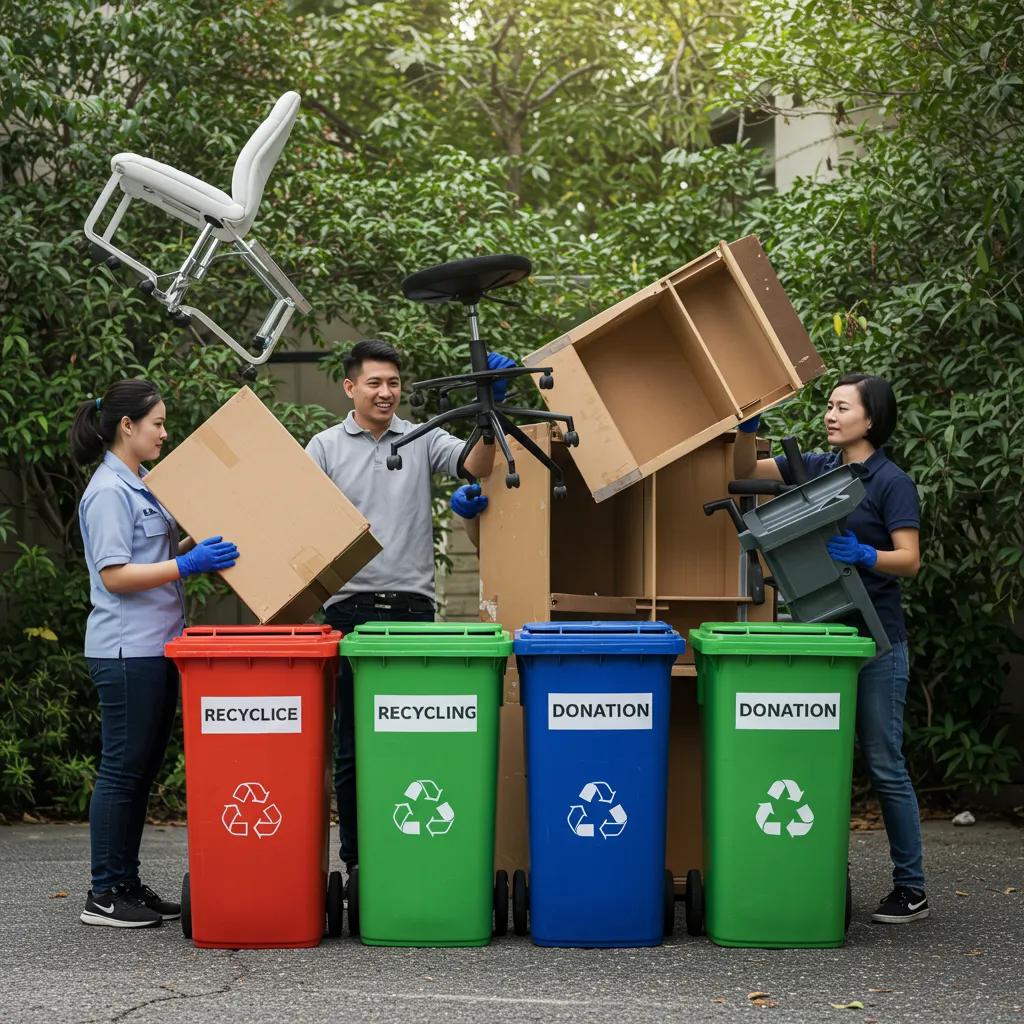
Sustainable disposal reduces landfill waste by diverting material streams—furniture, metals, and electronics—into reuse or recycling channels that recover resources and prevent hazardous leachate. Businesses that quantify diversion metrics can include verified data in CSR reports, boosting transparency with stakeholders and customers. Demonstrating reuse or donation activity enhances employer branding and can improve employee engagement by showing organizational commitment to sustainability. These combined benefits make sustainable disposal a measurable win for both environment and business reputation.
Sustainable Design with Waste Furniture Materials for Practitioners
Sustainability has become one of the core concerns of 21st century designers and makers. However, it is still evident that not every designer considers a choice of sustainable materials, manufacturing methods, afterlife or second use of their designs for furniture and other products unless the client, brief, customer or user demands it.
This research stemmed from a curiosity of the recycling practices of domestic households in England, the author’s country of residence, and investigates how designers can make use of post-consumer waste. The lack of established research for practice-based design practice with waste materials for designers has led to the development of a naturalistic approach within this work which is both craft-based and commercially focused. The central aim of the study is to explore how designs are sustainably approached in the commercial context of young furniture design companies in the UK, and to propose a set of practical guidance through design outcomes to help young entrepreneurs to deal with environmental issues via design and waste material reuse. This study functions as an articulation of the research journey that provides a discursive platform for dialogue and review, facilitating new insights into creative practice that contributes to new knowledge by efficiently crafting objects in a commercial context using discarded materials. This then proves that this form of waste can be adaptable and practicable as a main material for upcycling into commercial products in repeatable batch production runs.
Sustainable Design Approaches Using Waste Furniture Materials for Design Practitioners., 2019
The growing emphasis on sustainability in design and manufacturing highlights the potential for designers and businesses to innovate with waste furniture materials, transforming discarded items into valuable commercial products.
What Costs Are Involved in Office Furniture Removal and How Can Businesses Save Money?
Costs for office furniture removal are driven primarily by volume and handling complexity, with additional factors for e-waste processing, transportation distance, and access challenges. Understanding these cost drivers helps businesses plan budgets and identify savings: efficient professional crews reduce labor time, donation or recycling can offset disposal fees, and upfront quotes remove surprise charges. The list below summarizes typical cost factors and the table beneath maps cost factors to typical impacts so managers can evaluate quotes effectively.
Typical cost factors to expect:
- Volume and weight: Larger quantities increase load and transport costs.
- Labor and time: Disassembly and handling require more crew hours for complex items.
- E-waste handling: Electronics often incur special recycling fees and data security steps.
- Access and logistics: Tight corridors, stairs, or elevator scheduling can raise costs.
Preparing the space and consolidating items for pickup reduces on-site labor and can lower the overall price. The following table clarifies cost factors and their impact to support better vendor comparisons.
| Cost Driver | Cost Factor | Typical Impact |
|---|---|---|
| Item quantity | Volume/weight | Primary pricing driver: more items = higher total cost |
| Labor complexity | Disassembly/time | Specialized disassembly increases labor hours and cost |
| Material type | E-waste / hazardous | Requires certified handling; additional fees apply |
| Site access | Logistics | Stairs, narrow corridors, or off-hour windows increase time and price |
As practical savings tips, businesses should request clear, upfront quotes, consolidate pickups, schedule off-hours removal when feasible, and inquire about recycling or donation credits to reduce net costs.
(Company integration: Providers that offer clear, upfront quotes and same-day or next-day appointment availability—attributes highlighted by some commercial junk removal services—help businesses reduce indirect costs from downtime and avoid surprise fees.)
What Are Typical Pricing Factors for Office Furniture Removal Services?
Typical pricing factors include the total volume or weight of items, the labor time required for disassembly and handling, the complexity of access (stairs or tight corridors), and special handling needs for e-waste. Transportation distance and disposal fees at transfer or recycling facilities also affect the final price. Preparing a simple inventory and clear access plan before requesting quotes helps vendors provide accurate estimates. This preparation reduces the chance of change-order charges and ensures comparisons between providers are meaningful.
How Can Businesses Achieve Financial Benefits Through Professional Removal?
Businesses can save money by scheduling removals to minimize downtime, consolidating items to reduce multiple trips, and leveraging recycling or donation pathways that offset disposal costs. Obtaining multiple transparent quotes and asking vendors about credits for reusable items increases the likelihood of net savings. Professional crews also reduce indirect costs by preventing injury-related absences and avoiding delays that arise from inexpert removal efforts. Thoughtful planning and clear vendor communication turn removal from a cost center into a potential cost-avoidance strategy.
How Do Regulations and Compliance Affect Office Furniture Removal for Businesses?
Regulatory and compliance considerations shape how businesses dispose of furniture and electronics—local landfill restrictions, transport permits, and e-waste laws determine acceptable pathways and required documentation. Data security during office cleanouts adds another compliance layer: electronics must be wiped, destroyed, or handled by certified recyclers, and organizations should maintain chain-of-custody records. The checklist below identifies key items to verify and the following paragraphs explain implementation best practices to reduce legal and reputational risk.
Checklist for regulatory and compliance review:
- Municipal rules: Verify local rules on commercial disposal and landfill restrictions.
- Permits and transport: Confirm transporter permits and legal disposal destinations.
- E-waste regulations: Ensure electronics are handled by certified recyclers with data protocols.
- Documentation: Maintain disposal receipts and chain-of-custody records.
Confirming these items before removal protects businesses from fines and reputational harm and ensures disposal paths meet sustainability goals. The next table summarizes what to check and the typical compliance outcome to guide procurement and vendor selection.
| Compliance Area | What to Verify | Expected Business Outcome |
|---|---|---|
| Local disposal rules | Municipal restrictions and accepted material lists | Avoids fines and improper disposal |
| Transport permits | Carrier licensing and credentials | Legal transport and receipt acceptance |
| E-waste handling | Certified recycler and data destruction procedures | Secure data handling and regulatory compliance |
Adopting these checks as standard practice reduces regulatory risk and supports transparent reporting for stakeholders.
What Local Rules Should Businesses Know About Commercial Furniture Disposal?
Local disposal rules vary by municipality and can include restrictions on bulky-item landfill acceptance, required separation of materials, and permits for commercial haulers. Businesses should verify local permitted disposal destinations and any needed manifests or invoices that prove proper handling. Working with providers familiar with municipal rules ensures compliance and reduces administrative burden. Maintaining disposal receipts and diversion documentation supports audits and CSR reporting.
How Is Data Security Managed During Office Cleanouts and E-Waste Disposal?
Data security during cleanouts requires certified e-waste recycling partners, documented data-wiping or destruction processes, and maintained chain-of-custody records for all devices. Best practices include inventorying devices, performing certified data erasure or physical destruction, and obtaining certificates of destruction from recyclers. Requiring these steps in vendor agreements protects sensitive information and demonstrates due diligence during decommissioning. Proper documentation also supports regulatory compliance and reduces risk of data breaches during equipment disposal.


